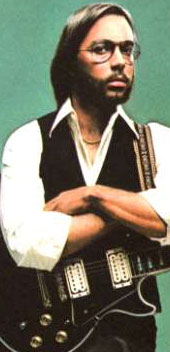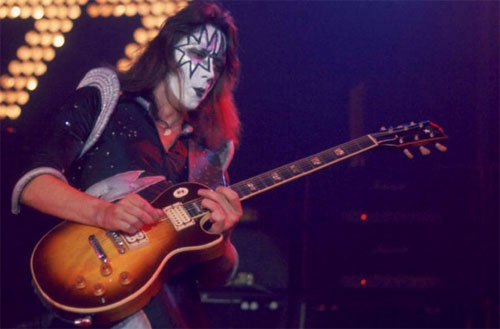The Super Distortion: A Classic Rock Classic
(Part 1)
DiMarzio’s Super Distortion (DSD) pickup doesn’t get a lot of love these days. But it should because it contributed to a lot of classic rock tones, and still can – if you use it right.
The DSD was intro’d in 1972, and was the first aftermarket replacement pickup. Its primary attribute was higher output, and as its name clearly states, it was all about pushing an amp into more distortion, aka sustain. Most (not all) classic rock guys wanted more sustain, not necessarily more “gain.” That just came with the territory.
Sustain from high-headroom 100w amps wasn’t easy to come by in the pre-master-volume days. Those amps were only intended to be loud – loud enough to project sound through bigger venues. So the guit-slingers wanted more sustain, maybe even more distortion, without having to use a fuzz pedal.
Take Ace Frehley as an example. One of the best-known users of the DSD, Ace said he used to run his amps with every knob at noon. Loud, yes. A recipe for sustain, no, especially since he supposedly used 6550 power tubes in his Marshalls, which are tubes that don’t compress as easily as EL34s.
So obviously the DSD helped him get his tone where he wanted it to go. And I have to think that his setup with regular PAFs would sound pretty lame.
Brief History
Anyhow, here’s a little more history on the DSD, from an interview with Larry DiMarzio and DiMarzio pickup guru Steve Blucher in The Guitar Pickup Handbook (which has a few interesting tidbits but that’s it – not worth buying).
Larry says he learned a lot from Bill Lawrence, but: “Please keep in mind that Bill’s ideas of what sounded good were very different from mine. Bill was all about jazz, and I was about sustain and tone.
“Originally I felt that the pickup-to-amp relationship had to be one of high gain. By overwhelming the front end of the amplifier, the effect was increased sustain.
“…by lowering [the guitar vol, a high-output pickup] would clean up – and by raising it to 10 it would put the amp into a smooth, natural overdrive. This is a very different experience from stepping on a [overdrive] box.”
Steve noted: “The original reason for the success of hotter pickups was the absence of high-gain amplifiers in the 1970s. The only ways to achieve thicker sound with more sustain with amplifiers of the era were with either a hotter pickup or a floor pedal.” [Both of which would slam an amp’s preamp, assuming the pedal was an overdrive/distorition pedal, not a fuzz.]
Another alternative, in the studio, was using a low-watt amp and cranking it.
The Recipe
So that’s the recipe for classic rock tones – or maybe even just plain good tones – using the DSD:
> Guitar with a “classic” body wood (mahog, mahog/maple top, ash, maybe alder – no basswood, etc.).
> Tube amp with hardly any preamp gain, as loud as you can stand it.
> Warm speaker(s), like Celestion Greenbacks.
> No pedals.
Tips
The DSD is a high-output, ceramic-magnet pickup, so warmth is not its strong suit. Not that it’s shrill – you just have to bear that in mind. If you’re using a DSD and find the sound too thin or tinny, here are some suggested fixes:
> Dial down the preamp gain or master vol. (You can do it, man! Just…turn…knob…left….)
> Lower the pickup.
> Wait for your strings to get older.
> Last resort: Try a lower-value volume pot, but only if you’re convinced the DSD can sound good in that guitar. Fact is, some guitars and pickups just don’t get along.
More
Do you NEED a DSD for more sustain or gain? With modern gained-out amps, obviously not. Larry himself said in the above interview, “With the introduction of higher adjustable gain on the front end of the amplifier, you could have a lower-output pickup still driving the amp into distortion.”
Do you need a DSD to mimic certain classic rock tones? If you’ve got the chops and the other gear, it sure helps. I can tell you from experience that playing some KISS and early Van Halen riffs with the DSD will get you eerily close tone-wise to the real thing.
Category: Ace Frehley, Al Di Meola, DiMarzio
















what a coincidence! I just found my DiMarzio Super Distortion pickups in my junk drawer. They were replaced by Seth Lovers, and I’ve been thinking of “re-purposing” them.
I stuck an Alnico II with a spacer in my DSD and it really kicks butt that way… but I might restore it back to normal for a future project. I truly great, versitile pickup. Obviously rock guys like Ace Frehley and Dave Murray are gonna love them, but Jerry Garcia, Al DiMeola and Frank Zappa also took a liking to its thick, lower-mid growl.
I disagree that the pickup isn’t warm. It might be the warmest-sounding high-output ceramic I’ve ever heard. A lot warmer than the Duncan ’59 I used to have in the bridge of my Superstrat.
There’s a lot of misinformation about older gear. A lot of it was started by Aspen Pittman of Groove tubes. This is where the whole myth of “power tube distortion” came from. Power tube distortion sounds really, really bad. What you are hearing with an old, non-master volume Marshall is pre-amp distortion plus the phase-inverter/splitter/ driver tube distorting. The power tubes aren’t distorting much at all, contrary to popular belief.
Also, the 70’s Marshalls distorted pretty damn good. In fact, for many people they distorted too early and too much. A DiMarzio Super Distortion through an old Marshall turned up to about “6” sounds really bitey and approaching heavy metal sounds. It’s hard to turn these amps up past “3” without getting at least some distortion.
The confusion with today’s players is some of the old gear is still around, but some of it isn’t. Plugging a Les Paul with a Super Distortion into a Line 6 Spider amp isn’t going to exhibit the characteristics that we experienced back in the day. LOL.